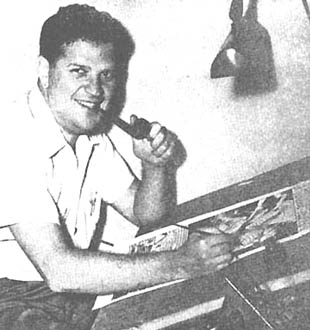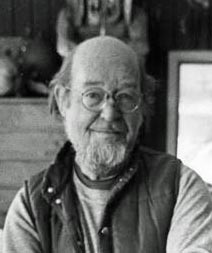
William Augustus Berry (born September 29, 1933, Jacksonville, Texas; died January 3, 2010, Columbia, Missouri) [1] [2] was an author, artist, and professor of art, known for his illustrations and colored pencil drawings.

William Augustus Berry (born September 29, 1933, Jacksonville, Texas; died January 3, 2010, Columbia, Missouri) [1] [2] was an author, artist, and professor of art, known for his illustrations and colored pencil drawings.
Berry earned a BFA at the University of Texas, Austin in 1955 and an MFA from the University of Southern California in 1957. Subsequently, he worked as an illustrator and painter in New York City.
In 1968, Berry began teaching art at the University of Texas, Austin, [1] where he became the first Art Director of Texas Monthly Magazine . [3] While teaching at UT Austin, he wrote his seminal textbook: Drawing The Human Form, [4] a book widely adopted by art departments across the country and cited as "excellent" by art historian Ernst Gombrich. [5]
From 1974 to 1978, Berry taught graphic design and illustration at Boston University, School of Visual Arts. In 1978, he became Professor of Art at the University of Missouri in Columbia [1] where he was given the Chancellor's Award for Outstanding Faculty Research and Creative Activity, 1983, and named a William H. Byler Distinguished Professor in 1989. [6] He served as chair for the department from 1995 to 1999. [1] The University of Missouri, in recognition of his scholarship and professional reputation, made him a Curators' Professor in 1991. [6] He retired in 1999 as Curators' Professor of Art Emeritus, a title he held for life. [6] [7]
Berry's artwork has been in over 500 exhibitions, in the U.S. and abroad, receiving over 100 awards and prizes. [6] Among the galleries that showed his work are: the Galleria Schneider, Rome, Italy; the Muscarelle Museum of Art, Williamsburg, VA; [8] United States Information Agency Gallery, Athens, Greece; [9] Espace Reduit, Cassis, France; [10] and the Charles Campbell Gallery, San Francisco. [8]
Berry traveled throughout the Middle East from 1965 to 1966, sponsored by a Dorothy Thompson Fellowship, resulting in an exhibition of photographs, drawings, and paintings shown at various American colleges in 1967-68. These formed the basis of a number of his later political illustrations. [7]
In 1990, Mid-America Arts Alliance and Exhibits USA, in partnership with the National Endowment for the Arts, sponsored a three-year traveling exhibition of 32 of Berry's large colored pencil drawings. In 2002, he received the CPSA Award for Exceptional Merit and CIPPY Trophy from the Colored Pencil Society of America. [9]
Public collections owning his work include: the Boston Museum of Fine Arts; [11] the Addison Gallery, Andover, MA; [12] Smith College Museum of Art, Northampton, MA; [13] the University of North Dakota, Grand Forks; the Hoyt Institute of Fine Arts, New Castle, PA; [8] and the Hallmark Art Collection, Kansas City, MO. [9]
Publications of Berry's illustrations, in a wide variety of media and styles, have been featured in various periodicals, such as The Reporter, Harper's , The New Leader , Esquire , Holiday Magazine , and Newsweek . [2]
Berry created covers for books published by Random House, Doubleday, Alfred A. Knopf, Charles Scribner's Sons, Time Inc., [9] and others. Among the books illustrated by Berry are: On Firm Ice, [14] Journey to the Arctic, [15] Still Quiet on the Western Front, [16] and Kennedy Without Tears. [17]
Berry has twice been profiled in the American Artist Magazine [18] [19] and is listed in Who's Who in American Art. [8]
Berry's honors include: fellowships and artist-in-residencies at the Altos de Chavon Foundation, Dominican Republic; the MacDowell Colony, Peterborough, NH; the Rockefeller Foundation, Villa Serbelloni, Bellagio, Italy; Lacoste School of the Arts, France; Montalvo Arts Center, Saratoga, CA; and the Camargo Foundation, Cassis, France. [1]
During these residencies, Berry, utilizing colored pencils, a cross-hatching technique and limited palette, created a series of still-life drawings focusing on the effect of light on geometric solids, which he constructed from paper. Drawing the solids axonometrically in order to "distance the viewer", Berry introduced objects from everyday life such as knives, pencils, or fruit, into his compositions. Berry wrote that the "geometric solids represent an intrusion of the ideal form of a truly Platonic type into the real world of objects.... a visual event that I find poetic and intriguing. It is the underlying theme in many of my drawings and is intended to make a metaphysical statement." [19]
Upon his retirement from teaching, Berry continued to be prolific - merging long-used techniques with new emphasis on combining computer-based images, photography, collage, and watercolor. His subject matter echoed earlier themes: still life, European architecture, political images, imaginary landscapes, and self-portraits, which number in the hundreds.
Berry's late works were executed in a loose style and expressive manner, which inadvertently document the progression of Parkinson's disease-related symptoms. [7]
Artist's website: http://www.williamaberry.com

Aaron Douglas was an American painter, illustrator, and visual arts educator. He was a major figure in the Harlem Renaissance. He developed his art career painting murals and creating illustrations that addressed social issues around race and segregation in the United States by utilizing African-centric imagery. Douglas set the stage for young, African-American artists to enter the public-arts realm through his involvement with the Harlem Artists Guild. In 1944, he concluded his art career by founding the Art Department at Fisk University in Nashville, Tennessee. He taught visual art classes at Fisk University until his retirement in 1966. Douglas is known as a prominent leader in modern African-American art whose work influenced artists for years to come.

Joseph Pennell was an American draftsman, etcher, lithographer, and illustrator for books and magazines. A prolific artist, he spent most of his working life in Europe, and developed an interest in landmarks, landscapes, and industrial scenes around the world. A student of James Lambdin and Thomas Eakins, he was later influenced by James McNeill Whistler. He was married to author Elizabeth Robins, and he also was a writer.

Jack Kamen was an American illustrator for books, magazines, comic books and advertising, known for his work illustrating crime, horror, humour, suspense and science fiction stories for EC Comics, for his work in advertising, and for the onscreen artwork he contributed to the 1982 horror anthology film Creepshow.

The Art Academy of Cincinnati is a private college of art and design in Cincinnati, Ohio. It was founded as the McMicken School of Design in 1869, and was a department of the University of Cincinnati, and later in 1887, became the Art Academy of Cincinnati, the museum school of the Cincinnati Art Museum. The college is accredited by the National Association of Schools of Art and Design.
Charles Green Shaw was an American painter, poet, writer, and illustrator. He was a key figure in early American abstract art. Shaw's paintings are part of most major collections of American Art, including the Art Institute of Chicago, Corcoran Gallery, the Metropolitan Museum of Art, the Musee d'Art Moderne de Paris, Museum of Fine Arts Boston, the Museum of Modern Art, the Smithsonian Institution, and the Whitney Museum.
Everett Raymond Kinstler was a most important American artist, whose official portraits include Presidents Gerald Ford and Ronald Reagan both of which hang in The White House. He was also a pulp and comic book artist, whose work appeared mainly in the 1940s and 1950s.

William Thomas Wiley was an American artist. His work spanned a broad range of media including drawing, painting, sculpture, film, performance, and pinball. At least some of Wiley's work has been referred to as funk art.
Wilber Moore Stilwell (1908–1974) was an American depression era artist, White House/National Gallery of Art/American Artists Professional League honoree, inventor, patent holder, author, and Chair of Art, University of South Dakota.
Paul Brooks Davis is an American graphic artist.
William Clutz was an American artist known for urban paintings, pastels, and charcoal drawings of pedestrian scenes transformed by light. He was associated with a revival in figurative representation in American art during the 1950s and 1960s.
Jody Mussoff is an American ceramist and artist, living in Virginia.

William Franklin McMahon was an American artist-reporter.

Ray L. Burggraf is an artist, color theorist, and Emeritus Professor of Fine Arts at Florida State University. According to Roald Nasgaard, Burggraf's paintings exhibit "visual excitation...pulsating patterns, vibrating after-images, weird illusionistic spaces, multifocal opticality, executed with knife-edge precision...crisp and elegant and radiant with light." From a historical perspective, Burggraf's work is "nature evocative...reach[ing] back to the modernist landscape tradition of the Impressionists and of Neo-impressionists like Seurat, who, in the late-nineteenth century immersed themselves in the color theories of Chevreul and Rood".

Fernand Lungren (1857–1932) was an American painter and illustrator. He is mostly known for his paintings of American South Western landscapes and scenes as well as for his earlier New York and European city street scenes.
Sedrick Ervin Huckaby (1975) is an American artist known for his use of thick, impasto paint to create murals that evoke traditional quilts and his production of large portraits that represent his personal history through images of family members and neighbors.
Ohotaq (Oqutaq) Mikkigak was a Cape Dorset based Inuk artist from southern Baffin Island. Mikkigak was involved with Cape Dorset printmaking in the program's early years, providing drawn designs for printing. Many of his works were printed and featured in the studio's annual collections, including Eskimo Fox Trapper and three pieces used in the Cape Dorset Studio's 40th anniversary collection. Mikkigak's work has also been included in of over twenty group exhibitions and was the subject of multiple solo exhibitions, including a show held by Feheley Fine Arts called Ohotaq Mikkigak: Imagined Landscapes.
James Claussen is a contemporary American lithographer and abstract painter. His lithography is distinguished by the technique of drawing directly on the stone surface as a second drawing process. His paintings combine surrealism with abstraction.
Frank Big Bear is a Native American artist born in Detroit Lakes, Minnesota and is a member of the Minnesota Chippewa Tribe, White Earth Band. As a multimedia Native artist, Big Bear is known for his colorful, abstract display through his drawings, paintings, and photo collages that address various messages about Big Bear's livelihood and worldly perception.

Robert Kennel DeWeese (1920–1990) was a Modernist artist in Montana who taught art at Montana State University and produced his own works with a focus in painting and printmaking.
Joseph Alexander Cain was an American artist, educator, and art critic. He led a combat art team during the Korean War, received degrees from the University of California at Berkeley, and was recognized for his art at the local, state, national, and international levels, being elected a Fellow of the Royal Society of Arts in London. Cain served the art community as educator, originator of the National Drawing and Small Sculpture Show at Del Mar College in Corpus Christi, Texas, and art critic. Personal and professional documents are included in the Archives of American Art at the Smithsonian Institution.